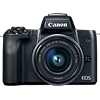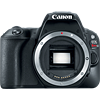Main
Model
Price
Advantages
launch
Announced
Body type
Camera subcategory
Sensor
Effective pixels
Max resolution
Sensor size
Sensor type
Processor
Image ratio w:h
Sensor photo detectors
Image
ISO
Boosted ISO (maximum)
White balance presets
Custom white balance
Image stabilization
Uncompressed format
JPEG quality levels
Photography features
Minimum shutter speed
Maximum shutter speed
Aperture priority
Shutter priority
Manual exposure mode
Built-in flash
Flash range
External flash
Continuous drive
Self-timer
Metering modes
Exposure compensation
AE Bracketing
Subject / scene modes
Screen / viewfinder
Articulated LCD
Screen size
Screen dots
Touch screen
Screen type
Live view
Viewfinder type
Viewfinder coverage
Viewfinder resolution
Viewfinder magnification
Videography features
File Format
Microphone
Speaker
Optics & Focus
Autofocus
Manual focus
Number of focus points
Lens mount
Focal length multiplier
Physical
Weight (inc. batteries)
Dimensions
Environmentally sealed
Battery
Battery details
Battery Life (CIPA)
Storage
Storage types
Connectivity
USB
USB charging
HDMI
Microphone port
Headphone port
Wireless
Wireless notes
Remote control
Other features
Orientation sensor
GPS
Timelapse recording
Samples
Videos
Summary
The Canon EOS M50 has more focus points in compare with the EOS Rebel SL2 (EOS 200D / Kiss X9): 143 vs 9. More number of focus points means less risk of losing focus lock when following a moving subject.
The EOS Rebel SL2 (EOS 200D / Kiss X9) battery life is better in compare to the Canon EOS M50 battery life. In accordance with CIPA standards the camera owner will be able to produce 650 photos with the EOS Rebel SL2 (EOS 200D / Kiss X9) and only 235 with the EOS M50. The Canon EOS M50 weighs 390g which is 63g lighter than the weight of the EOS Rebel SL2 (EOS 200D / Kiss X9).
The Canon EOS M50 and the EOS Rebel SL2 (EOS 200D / Kiss X9) have an equal number of advantages however as the EOS Rebel SL2 (EOS 200D / Kiss X9) has that is a really important advantage then this camera becomes the best buy.


